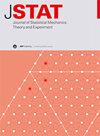The impact of crystal grain size on the behavior of disordered ferromagnetic systems: from thin to bulk geometry
IF 1.9
3区 物理与天体物理
Q2 MECHANICS
Journal of Statistical Mechanics: Theory and Experiment
Pub Date : 2024-08-22
DOI:10.1088/1742-5468/ad6977
引用次数: 0
Abstract
We report the findings of an extensive and systematic study on the effect of crystal grain size on the response of field-driven disordered ferromagnetic systems with thin, intermediate, and bulk geometry. For numerical modeling we used the athermal nonequilibrium variant of the random field Ising model simulating the systems with tightly packed and uniformly cubic-shaped, magnetically exchange-coupled crystal grains, conducted over a wide range of grain sizes. Together with the standard hysteresis loop characterizations, we offer an in-depth examination of the avalanching response of the system, estimating the effective grain-size-related exponents by analyses of the distributions of various avalanche parameters, average avalanche shape and size, and power spectra. Our results demonstrate that grain size plays an important role in the behavior of the system, outweighing the effect of its geometry. For sufficiently small grains, the characteristics of the system response are largely unaffected by grain size; however, for larger grains, the effects become more noticeable and show up as distinct asymmetry in the magnetization susceptibilities and average avalanche shapes, as well as characteristic kinks in the distributions of avalanche parameters, susceptibilities, and magnetizations for the largest grain sizes. Our insights, unveiling the sensitivity of the system’s response to the underlying structure in terms of crystal grain size, may prove beneficial in interpreting and analyzing experimental results obtained from driven disordered ferromagnetic samples of different geometries, as well as in extending the range of possible applications.晶体晶粒尺寸对无序铁磁系统行为的影响:从薄片到块状几何体
我们报告了一项广泛而系统的研究结果:晶体晶粒大小对具有薄型、中间型和块状几何形状的场驱动无序铁磁系统响应的影响。在数值建模中,我们使用了随机场伊辛模型的热非平衡态变体,模拟了具有紧密堆积和均匀立方体形状的磁交换耦合晶粒的系统,并在广泛的晶粒尺寸范围内进行了模拟。通过分析各种雪崩参数的分布、平均雪崩形状和尺寸以及功率谱,我们估算出了与晶粒尺寸相关的有效指数。我们的结果表明,晶粒尺寸在系统行为中起着重要作用,其影响超过了几何尺寸。对于足够小的晶粒,系统响应的特征基本上不受晶粒大小的影响;然而,对于较大的晶粒,其影响变得更加明显,表现为磁化电感和平均雪崩形状的明显不对称,以及雪崩参数、电感和磁化分布的特征性扭结。我们的见解揭示了系统响应对晶体晶粒大小的底层结构的敏感性,可能有助于解释和分析从不同几何形状的驱动无序铁磁样品中获得的实验结果,并扩大可能的应用范围。
本文章由计算机程序翻译,如有差异,请以英文原文为准。
求助全文
约1分钟内获得全文
求助全文
来源期刊
CiteScore
4.50
自引率
12.50%
发文量
210
审稿时长
1.0 months
期刊介绍:
JSTAT is targeted to a broad community interested in different aspects of statistical physics, which are roughly defined by the fields represented in the conferences called ''Statistical Physics''. Submissions from experimentalists working on all the topics which have some ''connection to statistical physics are also strongly encouraged.
The journal covers different topics which correspond to the following keyword sections.
1. Quantum statistical physics, condensed matter, integrable systems
Scientific Directors: Eduardo Fradkin and Giuseppe Mussardo
2. Classical statistical mechanics, equilibrium and non-equilibrium
Scientific Directors: David Mukamel, Matteo Marsili and Giuseppe Mussardo
3. Disordered systems, classical and quantum
Scientific Directors: Eduardo Fradkin and Riccardo Zecchina
4. Interdisciplinary statistical mechanics
Scientific Directors: Matteo Marsili and Riccardo Zecchina
5. Biological modelling and information
Scientific Directors: Matteo Marsili, William Bialek and Riccardo Zecchina

 求助内容:
求助内容: 应助结果提醒方式:
应助结果提醒方式:


